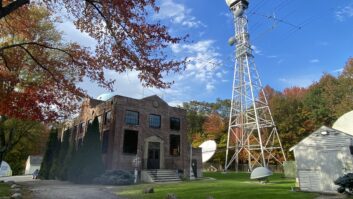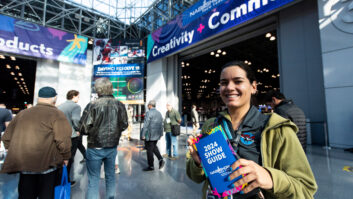
Well, it’s finally here, the new version of Adobe Audition CS5.5 for both the PC and Mac.
That’s right, I said Mac. Adobe has really stepped up its game — not only to be competitive with other editing software, but to beat other editing software.
Adobe made a huge leap when it released Audition 2.0. It was much more versatile and sleek than previous releases. Now Adobe has gone back to the drawing board for CS5.5 and made quite a powerful program that addresses many, though not all, shortcomings of previous iterations.
Tools
For as long as I can remember, Cool Edit/Audition had dicey time compression plagued with many artifacts. No more. In fact, Adobe gives you two algorithms to choose from: Their own much-improved time compression or iZotope Radius’ algorithm.
To put these to the test, I imported the toughest type of WAV file to time crunch/stretch, a song. Due to the complexity of music it is inherently much harder to stretch or crunch than spoken word and leads to more artifacts when time compression is applied.
Using the iZotope Radius algorithm, I performed a five-second stretch on a dynamic piece of music. This is a lot of time expansion. However, artifacts were minimal. There were noticeable artifacts, however, when using Adobe’s algorithm. The results were the same on both PC and Mac.
I was impressed with the iZotope Radius time stretch. Time expansion or compression on spoken word performs better when “solo instrument/voice” is selected.
There are cool new features in the history panel and effect rack. Let’s say I did several edits on a waveform. I now have a history panel on the left of the screen. This is a huge timesaver. If I wished to travel back to my first edit I can simply select that particular edit on the history panel and I’m there, without undoing anything.
However, I am unable to undo that particular edit without discarding all subsequent edits. To undo one particular edit without disrupting subsequent edits would be nice to see on future updates of the history panel.
We find the Effect rack in the edit view right above the history panel. This effects rack emulates the one that can be found in the multitrack session. I can apply a variety of effects and if I decide to eliminate one effect I simply uncheck it. I can rearrange the order of effects that I place on a waveform with much ease. For example, if I placed a compressor on a piece and then added reverb, I could easily change the order to reverb first and then compression.
(click thumbnail)

The multitrack window has undergone the most notable change.
First, you must now name and save a multitrack session before you begin editing or recording. While this is good practice in general, it is a little frustrating to have to name and save a session if you just want to perform a quick and dirty mix.
You might ask, “Can I import sessions from older version of Adobe Audition?”
Audition CS5.5 only recognizes sessions saved in XML. It will not recognize sessions that are saved in SES (the standard Audition session format). What does this mean? If you’re running Audition 3.0 you can resave all sessions as XML and then import them into CS5.5. However, if you are running older versions of Audition, you may run into trouble.
Obviously for some legacy users this is not good. Also, since every effect in Audition 3.0 did not make it into CS5.5, your newly imported session may be missing some effects. It is my understanding that there is a third-party conversion program that will take sessions from older versions of Audition and convert them to work in CS5.5. I have not tried this program and find it disappointing that I may have to incorporate another software program to upgrade my older multitrack sessions. Having countless sessions in older versions of Audition, I may be a little hesitant to migrate over to the newer platform.
[Ed. note: Adobe responds that the .SES translator tool can be found at www.aatranslator.com.au/ses2sesx.html. It’s free to download and use. Its author is accepting donations that will unlock broader functionality, like CEP session conversion to new format and third-party effects settings.]
Effects
Static groups appear to be a thing of the past. Adobe has eliminated locking waveforms together in a static group in the multitrack session. This is a little disappointing as having certain waveforms “permanently” locked together in a session is a handy tool when you are working with a template for imaging or commercials.
Another long-awaited feature in the multitrack session is applying effects only to certain clips on a track but not the entire track.
This feature is a tremendous help as it avoids wasting a whole track because you wish to have a high-pass filter on one little piece of your production. You simply have to select the portion of the track that you desire to have an effect and then choose your effect(s). Users will have an effect list for that particular clip located on the left of the multitrack screen as you would for the entire track.
PRODUCT CAPSULE
Adobe Audition Digital Audio Workstation Software
Plus
+ Now available for Mac
+ Improved time compression
+ Effects can now be applied to specific clips in the Multi-Track window
+ The ability to toggle to several multitrack sessions
+ Improved noise reduction
+ Ability to change the order of effects via the History Panel in the Edit Window
Minus
– Does not recognize .SES multitrack sessions
– No more static groups in Multi-Track
– No longer has the capability to burn CDs
Price: $349; $99 as an upgrade from Audition 1.5 and later, and Soundbooth CS3 and later
For information, contact Adobe at (800) 585-0774 or visit www.adobe.com/products/audition.
Have you ever been working on a session, perhaps a piece of imaging, and your PD comes in and asks you to play him/her a promo from another session? Previously you had to save what you were doing, close that session, then open the promo session. Not anymore. Adobe has allowed us to switch back and forth between many sessions, just as we would switch between files in the Edit view. This save mounds of time and makes workflow that much easier.
Surround sound is another interesting addition to Audition CS5.5. Some radio users may find a use for it; it does come in handy if you are designing audio for a film project that you wish to have in surround sound.
The noise reduction feature has always been one of my favorites in Audition. For those of us who can’t afford a CEDAR system or Sonic Solutions, Audition has a powerful audio forensics section.
I have been collecting and restoring jazz 78s and radio transcriptions from the 1920s and early ’30s since I was eight years old. The object of the game is to eliminate surface noise as much as you can without harming the musical information. Audition has improved the controls on its noise reduction tool. I now have even more control with the frequencies I attack and how much noise I wish to eliminate.
Raise your hands if you are familiar with a 60-cycle hum from a turntable that’s not properly grounded.The new de-hummer in Audition will tackle this issue with ease and few artifacts. With a load of presets or the ability to customize the tool to your liking, the new de-hummer is a welcome addition. How ’bout those sibilants? The newly redesigned de-esser does a decent job of fixing this annoying phenomenon.
CD Burning: A feature to disappear is the ability to burn CDs. As there are several programs that are able to burn CDs, the absence of this feature didn’t really impact my particular situation.
Overall, this is a solid, well researched program that features an ergonomic design to accommodate the rapid workflow of a production studio. While incorporating older multitrack sessions into CS5.5 may be a little difficult, I think that the improvements outweigh the shortcomings of the software. The introduction of Audition to the Mac platform makes it easy to transition a Mac facility to this program. Adobe seems to have listened to its customers and addressed many issues. I’m excited to see what future releases of Adobe Audition will unveil.
David Plotkin is a production director at a major New York City radio station and a long-time user of Adobe Audition.







